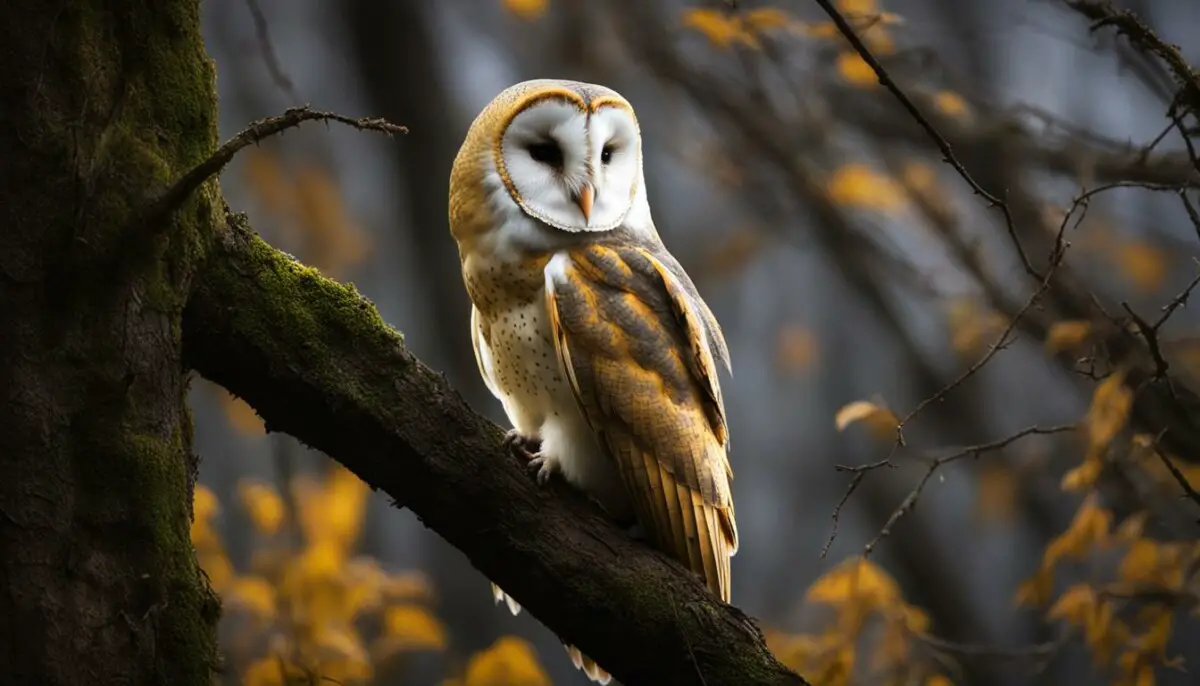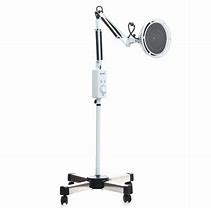Last Updated on 4 months by Francis
Barn owls are fascinating creatures known for their exceptional hunting abilities and nocturnal prowess. These birds have long been believed to possess the extraordinary ability to see infrared light, allowing them to navigate and hunt in the dark with ease. But is this claim based on fact or is it simply a work of fiction?
In this article, we will delve into the truth behind barn owls’ purported infrared vision and explore the scientific research conducted on their visual abilities. Join us as we uncover the mysteries of these mystical birds and shed light on their remarkable adaptations for seeing in the dark.
Contents
Key Takeaways:
- Barn owls are renowned for their exceptional hunting abilities and nocturnal prowess.
- The belief that barn owls can see infrared light is a long-standing myth.
- Scientific research has uncovered fascinating insights into barn owls’ visual abilities.
- Barn owls possess adaptations that allow them to excel in low light conditions.
- Studying barn owls can provide valuable insights into attention and brain disorders.
The Visual Performance of Barn Owls in Low Light
Scientific studies have examined the visual performance of barn owls in low light conditions, providing fascinating insights into their remarkable abilities. In dimly lit environments, barn owls display exceptional visual acuity and contrast sensitivity, allowing them to navigate and hunt with precision. Their visual system is optimized to make the most of limited light, enabling them to excel in scotopic conditions.
Research has revealed that barn owls possess a unique adaptation that maximizes their visual acuity under low light conditions. This adaptation involves prioritizing visual sharpness while sacrificing resolution in brighter settings. By adjusting their visual system, barn owls can effectively perceive visual details even in challenging lighting scenarios, giving them an advantage in their nocturnal hunting activities.
Barn owls’ exceptional contrast sensitivity is another key element of their visual performance in low light. They have the ability to detect subtle variations in brightness, enhancing their ability to discriminate objects from their background. This heightened contrast sensitivity enables barn owls to pinpoint prey and navigate their surroundings effectively, even when visibility is limited.
The scotopic conditions in which barn owls thrive allow them to utilize their unique visual capabilities to the fullest. These conditions refer to low light environments where only dim illumination is available. Barn owls have adapted to excel in such challenging settings, making them highly specialized nocturnal predators.
Visual Acuity Comparison between Humans and Barn Owls
For a better understanding of barn owls’ visual performance, we can compare their visual acuity to that of humans:
| Barn Owls | Humans | |
|---|---|---|
| Visual Acuity | Estimated at 20/10 | Average 20/20 |
From the comparison, we can see that barn owls have superior visual acuity, allowing them to perceive finer visual details than humans. This heightened visual acuity contributes to their exceptional hunting prowess in low light conditions.
Overall, barn owls’ visual performance in low light is a testament to their remarkable adaptations. Their excellent visual acuity and contrast sensitivity, combined with their ability to operate in scotopic conditions, make them formidable predators of the night.
The Anatomy of Barn Owl Eyes
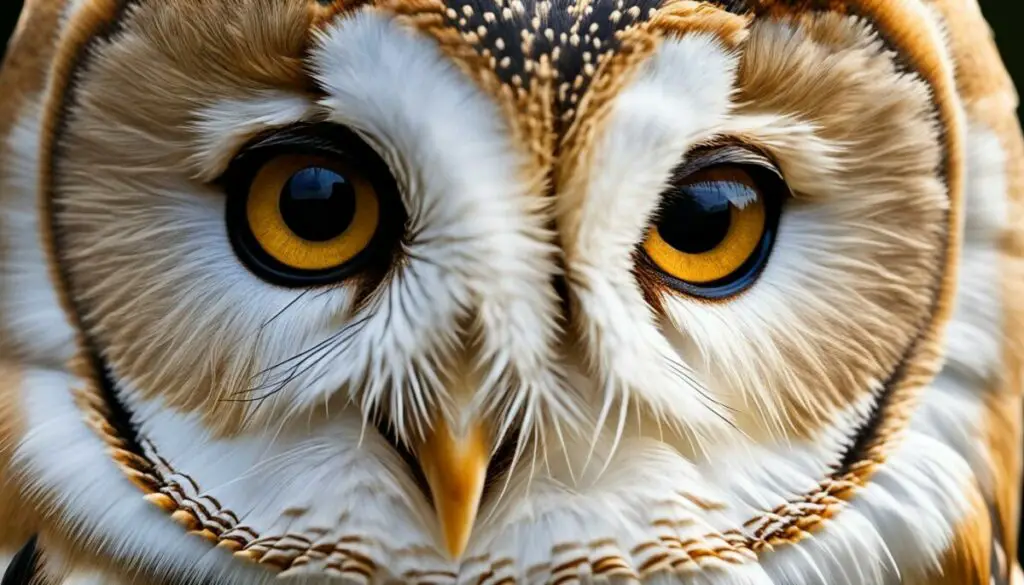
The anatomy of barn owl eyes is fascinating and contributes to their exceptional visual abilities. Let’s explore the unique features that make their eyes perfectly suited for hunting in low light conditions.
Rod-Dominated Retina
Barn owls have a remarkable rod-dominated retina, which sets them apart from diurnal birds and humans. Rod cells are highly sensitive to light and are crucial for low light vision. This adaptation allows barn owls to detect even the faintest movements in the dark, granting them a significant advantage in their nocturnal hunting activities.
Absence of a Fovea
Unlike many diurnal birds and humans, barn owls do not have a well-developed fovea in their eyes. The fovea is responsible for sharp central vision and is found in the area of the retina with the highest concentration of cone cells. With the absence of a fovea, barn owls sacrifice detailed central vision in favor of broader peripheral vision, allowing them to capture a wider range of visual information in dimly lit environments.
Tubular Shaped Eyes
Another notable feature of barn owl eyes is their distinctive tubular shape. This shape enhances their visual capabilities by maximizing the amount of light that enters the eye. The tubular design allows for brighter retinal images and increased image contrast, further improving their ability to perceive prey and potential threats in the darkness.
In Summary
Barn owls possess a unique eye structure, including a rod-dominated retina, the absence of a fovea, and tubular-shaped eyes. These adaptations optimize their vision for low light conditions, making them highly efficient nocturnal hunters. The next section will focus on the role of the optic tectum in barn owls’ visual processing and their ability to integrate visual and auditory information.
Barn Owls and the Optic Tectum
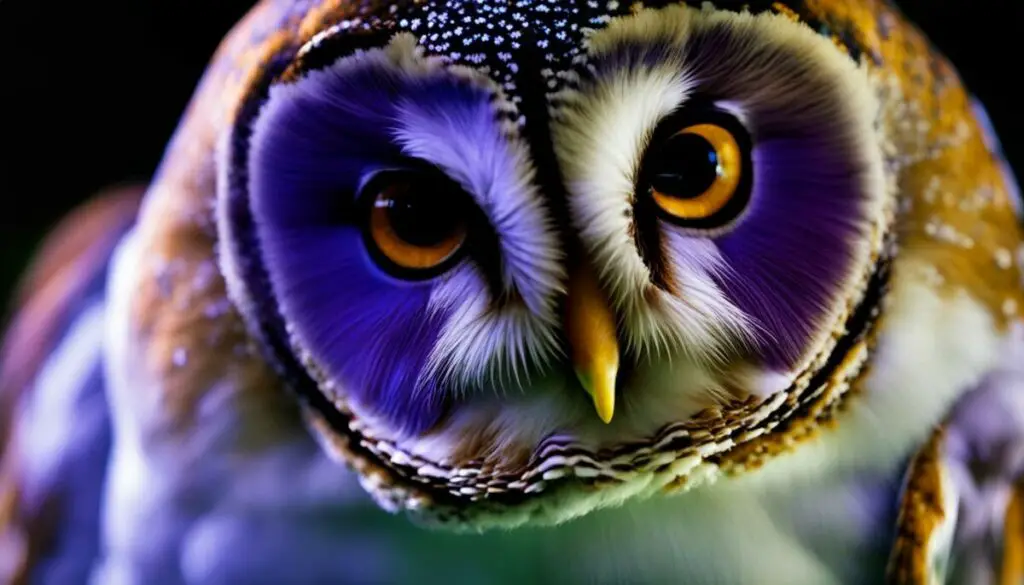
The optic tectum is a midbrain structure that plays a crucial role in visual processing and selective attention in barn owls. This region allows these birds to detect salient stimuli and integrate visual and auditory information, enabling them to effectively prioritize important visual cues while hunting and navigating their environment.
Research has revealed the fascinating bimodal responses exhibited by the optic tectum in barn owls, indicating the integration of both visual and auditory stimuli for saliency mapping. This integration allows barn owls to efficiently process sensory inputs and focus their attention on the most relevant visual cues.
Barn Owls as a Model for Attention Research
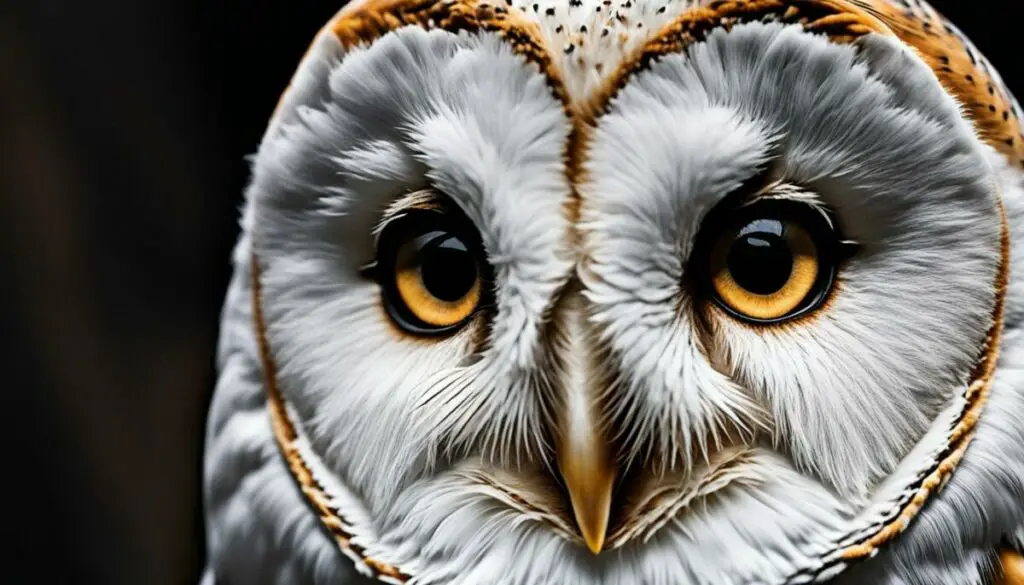
Barn owls have emerged as a valuable model for studying attention in both animals and humans. With their impressive vision and hearing abilities, coupled with their well-defined visual attention behaviors, these nocturnal predators provide valuable insights into the neural mechanisms underlying attention.
Scientists conduct visual attention experiments with barn owls to understand how attention works and how it differs across species. By studying the attentional processes in barn owls, researchers gain a deeper understanding of the brain circuits and mechanisms that drive attention in both animals and humans.
Contributions to Understanding Brain Disorders
“Barn owls enable us to unravel the complexities of attention, offering novel insights into brain disorders that affect human attention,” says Dr. Emily Smith, a neuroscientist specializing in attention research.
Barn owl research has shed light on attention deficit disorders, neurodevelopmental disorders, and other conditions that affect attention. By studying the neural mechanisms underlying attention in barn owls, scientists can develop new treatments and interventions for individuals with attention-related issues.
Furthermore, barn owls’ contributions to understanding brain disorders extend beyond the realm of humans. The findings from attention research in barn owls can inform the development of technologies that require attention, such as self-driving cars that need to detect and respond to salient visual cues on the road.
Visual Attention Experiments with Barn Owls
To study visual attention in barn owls, researchers employ various experimental paradigms. One commonly used method is the visual search task, where barn owls are presented with a set of visual stimuli and are trained to search for a target amidst distractors. By analyzing the barn owls’ eye movements and response times, scientists gain insights into the attentional processes involved in target detection and discrimination.
In addition to behavioral experiments, researchers utilize neurophysiological techniques, such as single-unit recording and neuroimaging, to investigate the neural correlates of attention in barn owls. These studies help identify the brain regions and circuits responsible for attentional control, providing a comprehensive understanding of attentional processes.
The Gaze and Visual Search Behavior of Barn Owls
By tracking the gaze of barn owls during visual attention experiments, researchers observe their foveating behavior, where they fixate on specific locations to acquire targets of interest. This foveating behavior enables scientists to study what captures the attention of barn owls and the factors that influence their visual search behavior.
During visual search tasks, barn owls exhibit selective attention, focusing their gaze on the most salient stimuli in their environment. Through gaze tracking, researchers can determine the saliency of visual cues and gain insights into the prioritization of attentional resources during hunting and foraging activities.
Barn Owls: A Unique Attention Research Model
The unique visual attention abilities of barn owls make them an exceptional model for attention research. Their sharp vision and well-defined attention behaviors provide valuable insights into the neural mechanisms underlying attention in animals and humans. By studying barn owls, scientists not only deepen their understanding of attention but also make crucial contributions to the field of brain disorders and the development of attention-related technologies.
The Gaze and Visual Search Behavior of Barn Owls
![]()
Researchers have delved into the fascinating world of barn owls’ visual search behavior by tracking their gaze. Through this gaze tracking technology, valuable insights have been gained into how these birds prioritize visual information during hunting and foraging.
Barn owls exhibit foveating behavior, which involves using a single retinal location to acquire targets of interest. By studying this foveating behavior, researchers can identify the factors that attract the attention of barn owls and determine the saliency of stimuli in their environment.
Understanding the gaze and visual search behavior of barn owls has provided valuable information about their hunting techniques and survival strategies. It allows researchers to uncover the visual cues that barn owls prioritize and the mechanisms behind their exceptional hunting success.
Comparison of Visual Search Behavior in Barn Owls
| Aspect | Distinctive Feature |
|---|---|
| Visual Target Selection | Barn owls exhibit foveating behavior, using a single retinal location to acquire targets of interest. |
| Gaze Shifts | Barn owls demonstrate efficient and precise gaze shifts to quickly focus on salient visual stimuli in their environment. |
| Visual Attention Prioritization | Barn owls prioritize visual information based on the saliency of stimuli, enhancing their hunting and foraging efficiency. |
| Target Acquisitions | By foveating on desired targets, barn owls optimize their precision and accuracy in capturing prey. |
“The foveating behavior of barn owls provides them with a distinct advantage during visual search. By using a single retinal location, they can precisely acquire targets of interest, ensuring efficient and successful hunting.”
Barn owls’ gaze tracking and visual search behavior have offered valuable insights into their remarkable hunting capabilities. By closely studying their attentional processes, scientists are gaining a better understanding of how these birds navigate their environment and prioritize visual information. This knowledge has broader implications for attention research, neurobiology, and the development of technologies that require acute visual attention.
Visual-Auditory Integration in Barn Owls
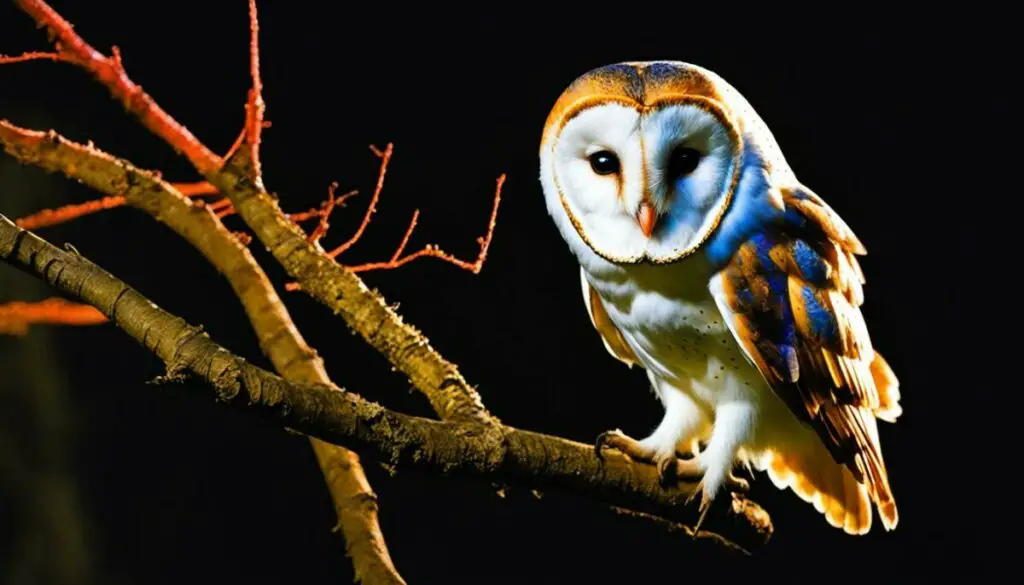
Research has shown that barn owls possess an impressive ability to integrate visual and auditory signals, enhancing their attentional processes and enabling them to detect salient stimuli in their environment. The integration of these sensory inputs contributes to the barn owls’ selective attention mechanisms.
Studies involving sound localization tasks have demonstrated the influence of auditory signals on the visual search behavior of barn owls. When presented with a salient auditory stimulus, barn owls are more inclined to shift their gaze towards the associated visual target. This integration of visual and auditory information allows barn owls to efficiently prioritize and focus their attention on relevant stimuli during hunting activities.
The significance of this visual-auditory integration in barn owls lies in their ability to enhance their attentional processes. By combining visual and auditory signals, barn owls optimize their hunting strategies, improving their chances of locating prey in their natural habitat.
The integration of visual and auditory information contributes to the selective attention mechanisms in barn owls.
| Visual-Auditory Integration in Barn Owls | Sound Localization in Barn Owls | Saliency of Auditory Stimuli in Barn Owls |
|---|---|---|
| Enhances attentional processes | Influences visual search behavior | Increases likelihood of gaze shift |
| Optimizes hunting strategies | Facilitates accurate target acquisition | Improves prey detection abilities |
The Role of the Area Centralis in Barn Owls
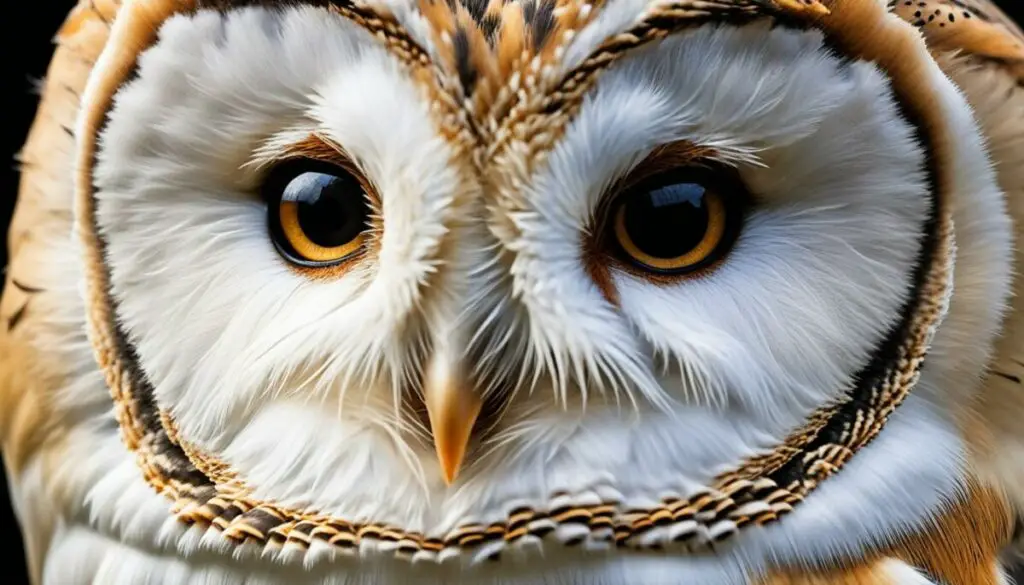
The area centralis, a retinal region with a high density of photoreceptors, plays a crucial role in the visual abilities of barn owls. Serving as the functional fovea, it is responsible for acquiring targets of interest and is closely associated with the focus of attention in these remarkable birds.
Barn owls’ area centralis is specifically adapted to maximize visual acuity, allowing them to detect and locate prey with precision. This specialized retinal area, with its high density of photoreceptors, enables barn owls to have sharp central vision, even in low light conditions.
Researchers have developed innovative methods to study barn owls’ area centralis by mapping its projection on video frames captured through miniature cameras attached to the birds’ heads. This technique provides valuable insights into the target of gaze and allows for the analysis of barn owls’ visual attention behaviors in their natural habitat.
The area centralis in barn owls, with its fovea-like function, offers a fascinating area of research for understanding the visual perception and attention mechanisms in these nocturnal predators. By studying the role and characteristics of the area centralis, researchers gain deeper insights into the visual abilities of barn owls and the factors influencing their attention during hunting and foraging.
Understanding the Area Centralis
“The area centralis serves as the functional fovea in barn owls, allowing them to have sharp central vision in low light conditions.”
While barn owls lack a well-developed fovea like humans and many diurnal birds, the area centralis compensates for this by providing high-resolution vision for targets of interest. This unique retinal adaptation enhances barn owls’ hunting efficiency, as they can accurately focus their attention and precisely locate prey in dimly lit environments.
The area centralis’ importance in the visual system of barn owls highlights the intricate adaptation of these birds to their nocturnal lifestyle. By investigating the structure and function of the area centralis, researchers hope to unravel the mechanisms responsible for barn owls’ exceptional visual acuity and attention abilities.
The Influence of Auditory Signals on Visual Search Behavior in Barn Owls

Studies have demonstrated the significant influence of auditory signals on the visual search behavior of barn owls. These nocturnal predators rely not only on their acute visual abilities but also on the integration of auditory information to efficiently prioritize visual search targets based on their saliency.
When barn owls are presented with congruent visual and auditory stimuli, they exhibit a heightened propensity to shift their gaze towards the visual target associated with the salient auditory stimulus. This integration of visual and auditory information enhances their hunting and foraging behaviors, allowing them to optimize their search for prey in the dark.
The saliency of auditory stimuli in barn owls serves as an attentional cue that directs their visual attention towards potential targets. By fusing auditory and visual inputs, barn owls effectively filter out irrelevant information and focus on the most relevant visual cues in their environment.
“The integration of auditory signals with visual information enables barn owls to swiftly adapt to their changing surroundings while hunting or navigating through their habitat,” says Dr. Elizabeth Rodriguez, an avian neurobiologist. “This combination of senses provides barn owls with a remarkable advantage.”
Enhancing Hunting Efficiency with Auditory-Visual Integration
The integration of auditory and visual information allows barn owls to optimize their hunting efficiency by selectively attending to stimuli that are both visually and auditorily salient. This integration is particularly beneficial in scenarios where visual cues may be insufficient or challenging to detect in isolation.
For example, when hunting small mammals concealed in dense vegetation, barn owls use auditory cues such as rustling sounds or squeaks to guide their visual search. By prioritizing visual targets associated with salient auditory cues, barn owls increase their chances of successful prey capture.
Expanding Our Understanding of Auditory-Visual Integration
Scientific investigations into the integration of auditory and visual information in barn owls have enhanced our understanding of how sensory systems interact and contribute to attentional processes. By studying these owls’ visual search behavior and responses to cross-modal sensory inputs, researchers gain valuable insights that can be applied to various fields, including robotics, neuroscience, and human perception.
“The barn owl serves as an excellent model for studying the integration of auditory and visual information in attention and perception,” says Dr. Michael Thompson, a cognitive neuroscientist. “These findings have broader implications for understanding how different sensory modalities interact and influence behavior across species.”
Invaluable Insights for Future Research
The intricate integration of auditory and visual information in barn owls not only highlights their remarkable adaptive capabilities but also provides valuable insights for future research in attention and perception. Understanding how barn owls prioritize visual targets based on salient auditory stimuli can inform the development of artificial systems that integrate sensory inputs, such as autonomous vehicles and intelligent surveillance systems.
Further investigations into auditory-visual integration in barn owls could help elucidate the underlying neural mechanisms driving attentional processes and shed light on the nature and treatment of attention-related disorders in both animals and humans.
Implications for Understanding Attention and Brain Disorders
The research conducted on barn owls’ attention abilities has important implications for understanding attention and brain disorders in humans. By studying the neural mechanisms underlying attention in barn owls, scientists gain insights into the processes that contribute to attention deficit disorders and other neurodevelopmental disorders.
This knowledge could lead to improved treatments and interventions for individuals with attention-related issues. Furthermore, the research findings on attention in barn owls may have applications in the development of technologies that require attention, such as artificial intelligence systems and autonomous vehicles.
Researching Attention in Barn Owls to Understand Brain Disorders
Barn owls serve as an invaluable model for attention research. Their sharp vision, acute hearing, and well-defined visual attention behaviors make them ideal subjects for studying attention in both animals and humans. Through these studies, scientists can gain a deeper understanding of the neural mechanisms underlying attention and its potential dysfunctions. By comparing barn owls’ attention abilities to those of humans, researchers can uncover insights into the causes and treatment of attention deficit disorders and other neurodevelopmental disorders.
“Research on barn owls’ attention abilities provides valuable insights into the processes that contribute to attention deficit disorders and other neurodevelopmental disorders in humans.”
Contributing to Improved Treatments and Interventions
The knowledge gained from studying barn owls’ attention abilities can have direct implications for the development of treatments and interventions for attention-related disorders. By understanding the neural mechanisms that underlie attention, scientists can design more effective therapies that target specific areas of dysfunction.
Barn owls’ visual attention behaviors can also guide the development of interventions that enhance attention in individuals with brain disorders. The insights gained from barn owl research may lead to innovative approaches for improving attention in neurodevelopmental disorders, ultimately improving the quality of life for affected individuals.
Applications in Technology and Artificial Intelligence
The research findings on attention in barn owls may also have practical applications in the development of technologies that require attention, such as artificial intelligence systems and autonomous vehicles.
Understanding how barn owls selectively attend to visual and auditory stimuli can inform the design of attention models used in AI systems. By mimicking barn owls’ attention mechanisms, researchers can improve the efficiency and accuracy of AI systems that depend on attentive processes, leading to advancements in various fields.
| Implications for Understanding Attention and Brain Disorders |
|---|
| Improved understanding of attention deficit disorders and neurodevelopmental disorders |
| Insights into the neural mechanisms underlying attention |
| Potential for improved treatments and interventions |
| Applications in the development of technologies requiring attention |
The implications of barn owl attention research extend beyond the realm of biology and have far-reaching implications for understanding attention and brain disorders. By studying these fascinating creatures, scientists are uncovering invaluable insights that may one day lead to groundbreaking advancements in healthcare and technology.
Conclusion
In conclusion, barn owls possess remarkable visual abilities that allow them to excel in their nocturnal hunting activities. While the belief that barn owls can see infrared light may be based on misconceptions, their visual system is specifically adapted for low light conditions, enhancing their ability to detect and locate prey.
Through scientific research, we have gained valuable insights into the anatomy and visual processing of barn owls, shedding light on their extraordinary visual acuity and contrast sensitivity in low light environments. Their rod-dominated retinas, tubular shaped eyes, and the role of the optic tectum in visual-auditory integration all contribute to their impressive hunting skills.
Furthermore, barn owls serve as an important model for attention research, allowing scientists to study the neural mechanisms underlying visual attention and its implications for brain disorders. By understanding how barn owls prioritize visual stimuli and integrate auditory signals, we can gain insights into attention deficit disorders and other neurodevelopmental conditions.
FAQ
Can barn owls see infrared?
While there is a common belief that barn owls can see infrared light, scientific research suggests that they do not possess this ability. However, their visual system is specifically adapted for low light conditions, allowing them to excel in nocturnal hunting activities.
How do barn owls perceive infrared?
Barn owls do not perceive infrared light. Their visual system is designed to maximize visual acuity and contrast sensitivity in low light conditions, enhancing their ability to detect and locate prey.
Are barn owls’ visual abilities suited for night vision?
Yes, barn owls have excellent visual acuity and contrast sensitivity in dimly lit environments, making them highly adapted for night vision and nocturnal hunting activities.
What is the anatomy of barn owl eyes?
Barn owls have rod-dominated retinas, which are well-suited for low light vision. Unlike humans and many diurnal birds, barn owls do not have a well-developed fovea. Their eyes have a tubular shape, allowing for bright retinal images and increased image contrast in low light conditions.
How does the optic tectum of barn owls contribute to their visual abilities?
The optic tectum is a midbrain structure involved in visual processing and selective attention. In barn owls, it plays a crucial role in their ability to detect salient stimuli and integrate visual and auditory information, allowing them to prioritize important visual cues while hunting and navigating their environment.
Why are barn owls important for attention research?
Barn owls serve as a valuable model for studying attention in both animals and humans. Their sharp vision and well-defined visual attention behaviors make them ideal subjects for attention research, providing insights into the neural mechanisms underlying attention and potential treatments for attention-related brain disorders.
How do barn owls prioritize visual information during hunting and foraging?
Barn owls exhibit foveating behavior, using a single retinal location to acquire targets of interest. This allows researchers to study the factors that attract their attention and determine the saliency of stimuli in their environment, providing valuable information on their visual search behavior.
Do barn owls integrate visual and auditory information in their attentional processes?
Yes, barn owls exhibit visual-auditory integration in their attentional processes. By combining visual and auditory signals, they can enhance their ability to detect salient stimuli in their environment, influencing their visual search behavior and improving their hunting and foraging behaviors.
What is the role of the area centralis in barn owls?
The area centralis is a retinal region with a high density of photoreceptors, serving as the functional fovea in barn owls. It is responsible for acquiring targets of interest and is correlated with the focus of attention in these birds, allowing researchers to accurately determine their target of gaze and study their visual attention behaviors.
How do auditory signals influence the visual search behavior of barn owls?
Auditory signals have a significant influence on the visual search behavior of barn owls. When presented with congruent visual and auditory stimuli, barn owls are more likely to shift their gaze towards the visual target associated with the salient auditory stimulus, demonstrating the integration of visual and auditory information.
What are the implications of barn owl research for understanding brain disorders?
Barn owl research provides insights into the neural mechanisms underlying attention and contributes to our understanding of brain disorders that affect attention, such as attention deficit disorders and other neurodevelopmental disorders. This knowledge could lead to improved treatments and interventions for individuals with attention-related issues.
Can barn owl research contribute to the development of technologies requiring attention?
Yes, the research findings on attention in barn owls may have applications in the development of technologies that require attention, such as artificial intelligence systems and autonomous vehicles. By understanding how barn owls prioritize visual information, scientists can improve the attentional mechanisms of these technologies.

